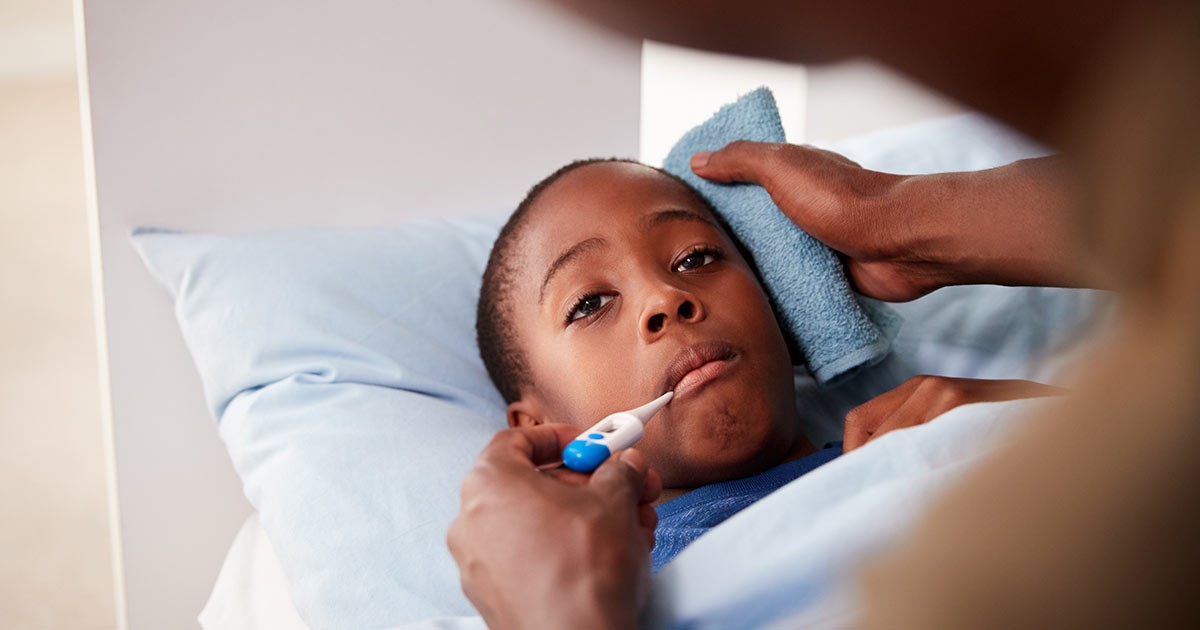Home>Health & Nutrition>Understanding And Managing A 103 Degree Fever


Health & Nutrition
Understanding And Managing A 103 Degree Fever
Modified: April 28, 2024
Learn how to understand and manage a 103-degree fever with expert health and nutrition tips. Stay informed and take control of your health today.
(Many of the links in this article redirect to a specific reviewed product. Your purchase of these products through affiliate links helps to generate commission for Temperatures.com, at no extra cost. Learn more)
Table of Contents
Recognizing the Symptoms of a 103 Degree Fever
When it comes to recognizing the symptoms of a 103-degree fever, it's essential to be aware of the signs that indicate a significant increase in body temperature. A fever of 103 degrees Fahrenheit is considered high and can be indicative of an underlying health issue. Understanding the symptoms associated with this elevated body temperature is crucial for prompt and effective management.
-
Elevated Body Temperature: The primary indicator of a 103-degree fever is, of course, the elevated body temperature itself. Using a reliable thermometer to measure body temperature is essential. A reading of 103 degrees Fahrenheit or 39.4 degrees Celsius indicates a fever that requires attention.
-
Chills and Shivering: Individuals with a 103-degree fever may experience chills and uncontrollable shivering as the body attempts to regulate its temperature. These symptoms often accompany the fever and can be distressing for the individual.
-
Sweating: On the other end of the spectrum, profuse sweating can also be a symptom of a 103-degree fever. The body's attempt to cool down can lead to excessive sweating, which may leave the individual feeling clammy and uncomfortable.
-
Headache and Body Aches: A high fever can often be accompanied by a severe headache and generalized body aches. These symptoms can significantly impact an individual's comfort and well-being.
-
Fatigue and Weakness: Feeling unusually tired and weak is another common symptom of a 103-degree fever. The body's immune response to an infection or illness can lead to increased fatigue and a lack of energy.
-
Rapid Heart Rate and Breathing: In some cases, a high fever can lead to an elevated heart rate and rapid breathing. These physiological responses are the body's way of coping with the increased temperature and can be indicative of a significant fever.
Recognizing these symptoms is crucial for taking appropriate steps to address a 103-degree fever. Understanding the signs of a high fever enables individuals to seek timely medical attention and implement effective home remedies to manage the fever and its associated discomfort.
Read more: Understanding And Managing Fever In Toddlers
Causes of a 103 Degree Fever
A fever of 103 degrees Fahrenheit, or 39.4 degrees Celsius, can be a concerning indication of an underlying health issue. Understanding the potential causes of such a high fever is crucial for effective management and treatment. Several factors can contribute to the onset of a 103-degree fever, ranging from common infections to more serious medical conditions.
Infections
In many cases, a 103-degree fever is the body's natural response to an infection. Viral and bacterial infections, such as influenza, pneumonia, urinary tract infections, and strep throat, can lead to a significant increase in body temperature. These infections trigger the body's immune response, causing the release of pyrogens, which reset the body's internal thermostat, leading to fever.
Inflammatory Conditions
Certain inflammatory conditions, such as rheumatoid arthritis and inflammatory bowel disease, can also result in a 103-degree fever. These conditions involve the body's immune system attacking its own tissues, leading to inflammation and, in some cases, fever.
Heat-Related Illnesses
Exposure to extreme heat or prolonged physical exertion in hot conditions can lead to heat-related illnesses, including heat exhaustion and heatstroke. These conditions can cause the body's temperature to rise significantly, resulting in a fever of 103 degrees or higher.
Medications
Some medications, particularly certain antibiotics and antipsychotic drugs, can lead to a high fever as a side effect. It's essential to be aware of the potential side effects of medications and consult a healthcare professional if a fever develops after starting a new medication.
Autoimmune Disorders
Autoimmune disorders, such as lupus and multiple sclerosis, can cause the immune system to mistakenly attack healthy tissues, leading to inflammation and fever. These conditions can result in recurrent episodes of high fever, often accompanied by other symptoms related to the specific autoimmune disorder.
Cancer
In some cases, a 103-degree fever can be a sign of an underlying cancer, such as leukemia or lymphoma. Cancer-related fevers are often caused by the body's immune response to the presence of cancer cells or the release of certain substances by the tumor.
Understanding the potential causes of a 103-degree fever is essential for determining the appropriate course of action. If an individual experiences a fever of this magnitude, it is crucial to seek medical attention to identify the underlying cause and initiate the necessary treatment.
When to Seek Medical Attention for a 103 Degree Fever
When faced with a 103-degree fever, it is crucial to be aware of the circumstances that warrant seeking medical attention. While a fever is the body's natural response to infections and other health challenges, a temperature of 103 degrees Fahrenheit demands careful consideration and, in some cases, prompt medical intervention.
If an individual, especially a child, experiences a 103-degree fever, it is essential to monitor the duration and accompanying symptoms. Seeking medical attention is advisable in the following situations:
-
Prolonged Fever: If the fever persists for more than 3 days, medical evaluation is necessary to identify the underlying cause and initiate appropriate treatment. Prolonged fevers can indicate a more serious underlying condition that requires medical attention.
-
Severe Symptoms: When a 103-degree fever is accompanied by severe symptoms such as difficulty breathing, chest pain, confusion, severe headache, or persistent vomiting, immediate medical attention is crucial. These symptoms can indicate a more severe illness that requires prompt evaluation and treatment by healthcare professionals.
-
Infants and Young Children: For infants and young children, a 103-degree fever can be particularly concerning. It is recommended to seek medical attention if a baby under 3 months of age has a rectal temperature of 100.4 degrees Fahrenheit (38 degrees Celsius) or higher. For older children, especially if they appear lethargic, irritable, or have difficulty breathing, medical evaluation is essential.
-
Underlying Health Conditions: Individuals with pre-existing health conditions, such as heart disease, diabetes, or a weakened immune system, should seek medical attention if they develop a 103-degree fever. Fevers in these individuals can indicate a more serious health concern and require careful evaluation by healthcare providers.
-
No Improvement with Home Care: If home remedies and over-the-counter fever-reducing medications do not effectively reduce the fever or alleviate symptoms, seeking medical advice is recommended. Persistent fevers despite home care may indicate a need for medical intervention to address the underlying cause.
In summary, a 103-degree fever should prompt careful consideration and, in many cases, medical evaluation. It is essential to monitor the duration of the fever, accompanying symptoms, and the individual's overall health status to determine when seeking medical attention is necessary. Timely intervention can help identify and address the underlying cause of the fever, ensuring appropriate treatment and a swift return to health.
Read more: Understanding The Symptoms Of Fever
Home Remedies for Managing a 103 Degree Fever
When faced with a 103-degree fever, implementing home remedies can play a crucial role in managing the fever and alleviating associated discomfort. While medical attention may be necessary in certain situations, home care can help reduce the fever and provide relief from symptoms. It's important to note that these remedies are intended to complement medical advice and treatment, and individuals should consult healthcare professionals, especially in cases of prolonged or severe fever.
Stay Hydrated
Maintaining adequate hydration is essential when managing a 103-degree fever. Fever can lead to increased fluid loss through sweating and evaporation, potentially leading to dehydration. Drinking plenty of water, clear broths, and electrolyte-rich beverages can help replenish lost fluids and support the body's natural healing process.
Rest and Comfort
Rest is crucial for allowing the body to combat the underlying cause of the fever. Adequate rest can help conserve energy and redirect the body's resources toward fighting off infections or addressing other health issues. Creating a comfortable and restful environment, including a cool room and comfortable bedding, can contribute to overall well-being during a fever.
Cool Compresses
Using cool compresses or damp washcloths on the forehead, neck, and armpits can help lower body temperature and provide relief from the discomfort associated with a 103-degree fever. These simple and effective measures can aid in regulating body temperature and reducing the intensity of the fever.
Lukewarm Bath
A lukewarm bath or sponge bath can be beneficial in managing a high fever. The gentle cooling effect of the water can help bring down body temperature and provide temporary relief from the symptoms of fever. It is important to avoid using cold water, as it can lead to shivering and potentially raise body temperature.
Over-the-Counter Medications
Over-the-counter fever-reducing medications, such as acetaminophen or ibuprofen, can be used to help lower a 103-degree fever. It is essential to follow the recommended dosage and guidelines provided on the medication packaging. However, it's important to consult a healthcare professional, especially when considering these medications for children or individuals with pre-existing health conditions.
Monitor and Reevaluate
While implementing home remedies, it is crucial to monitor the individual's temperature and overall condition regularly. If the fever persists or worsens despite home care, seeking medical advice is advisable. Monitoring for any concerning symptoms and reevaluating the effectiveness of home remedies is essential for ensuring the well-being of the individual.
Implementing these home remedies can contribute to managing a 103-degree fever and providing comfort during the recovery process. However, it is important to emphasize the significance of seeking medical attention, especially in cases of prolonged or severe fever, to identify and address the underlying cause effectively.
Medical Treatments for a 103 Degree Fever
When facing a 103-degree fever, medical treatments may be necessary to address the underlying cause and alleviate the symptoms effectively. Healthcare professionals play a crucial role in evaluating the individual's condition, identifying the root cause of the fever, and determining the most appropriate course of treatment. Medical interventions for a 103-degree fever may include the following:
Read more: Understanding Fever: Causes And Symptoms
Prescription Medications
In cases where the fever is attributed to a bacterial infection, such as pneumonia or a urinary tract infection, healthcare providers may prescribe antibiotics to combat the underlying bacterial cause. These medications are tailored to target specific types of bacteria, helping to resolve the infection and reduce the fever.
Antiviral Medications
If the 103-degree fever is a result of a viral infection, such as influenza or certain types of respiratory viruses, antiviral medications may be prescribed. These medications work to inhibit the replication of viruses in the body, aiding in the resolution of the viral infection and subsequent reduction of the fever.
Intravenous Fluids
For individuals experiencing severe dehydration or those unable to maintain adequate fluid intake orally, intravenous (IV) fluids may be administered. IV fluids help restore hydration, replenish electrolytes, and support the body's overall function, particularly in cases where fever has led to significant fluid loss.
Fever-Reducing Medications
In situations where the fever is causing significant discomfort or poses a risk of complications, healthcare professionals may administer fever-reducing medications, such as acetaminophen or ibuprofen, through appropriate medical channels. These medications can help lower body temperature and alleviate associated symptoms.
Hospitalization and Monitoring
In severe cases of a 103-degree fever, especially when accompanied by complications or underlying health conditions, hospitalization may be necessary. Hospital-based treatment allows for close monitoring of the individual's condition, administration of intravenous medications and fluids, and comprehensive medical care to address the fever's underlying cause.
Supportive Care
Healthcare professionals may provide supportive care to manage the symptoms of a 103-degree fever, including measures to alleviate discomfort, promote rest, and address specific symptoms such as headache, body aches, and respiratory distress. Supportive care aims to enhance the individual's comfort and aid in the overall recovery process.
It is important to emphasize that medical treatments for a 103-degree fever should be administered under the guidance of healthcare professionals. Prompt medical attention and appropriate interventions are essential for effectively managing the fever, addressing its underlying cause, and ensuring the individual's well-being.
These medical treatments, tailored to the specific circumstances of the individual's condition, play a vital role in resolving the fever and supporting the individual's recovery. Seeking timely medical care and following the guidance of healthcare providers are fundamental steps in addressing a 103-degree fever and promoting optimal health outcomes.










